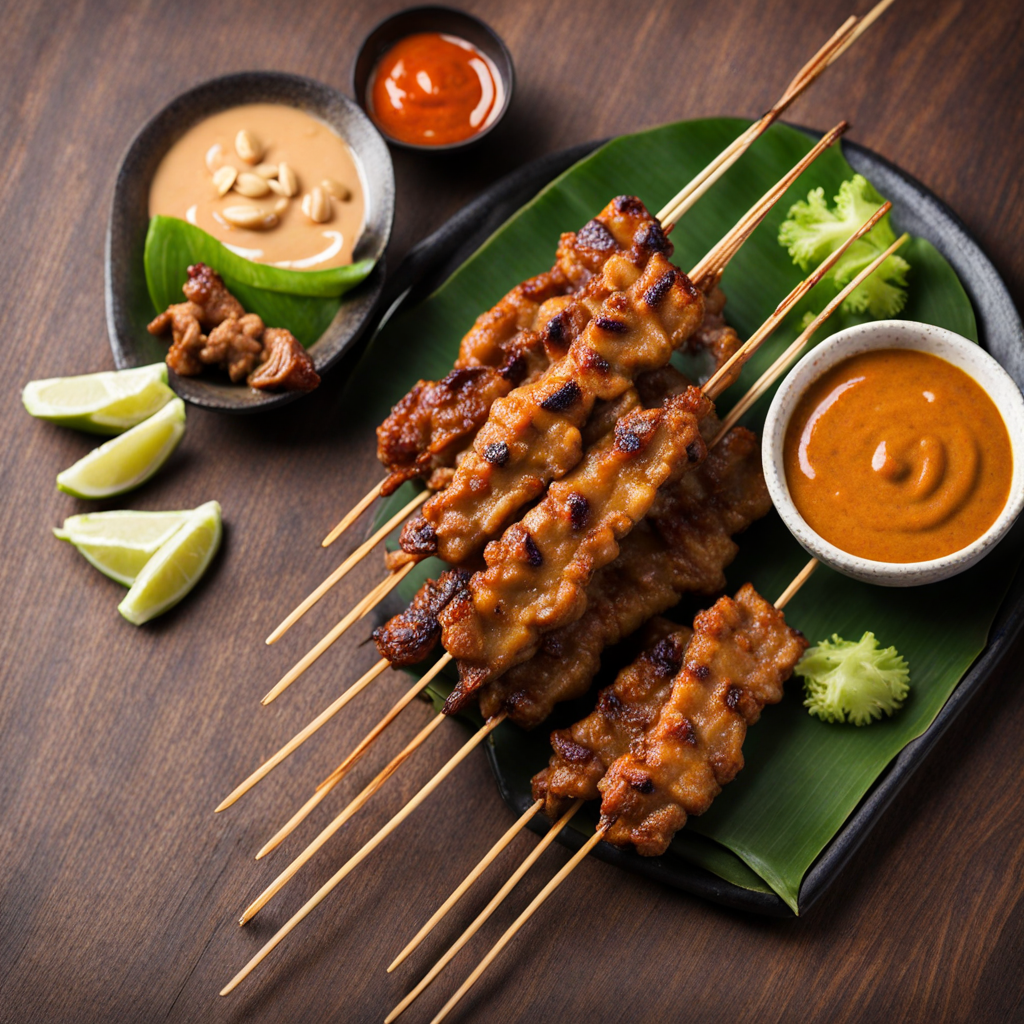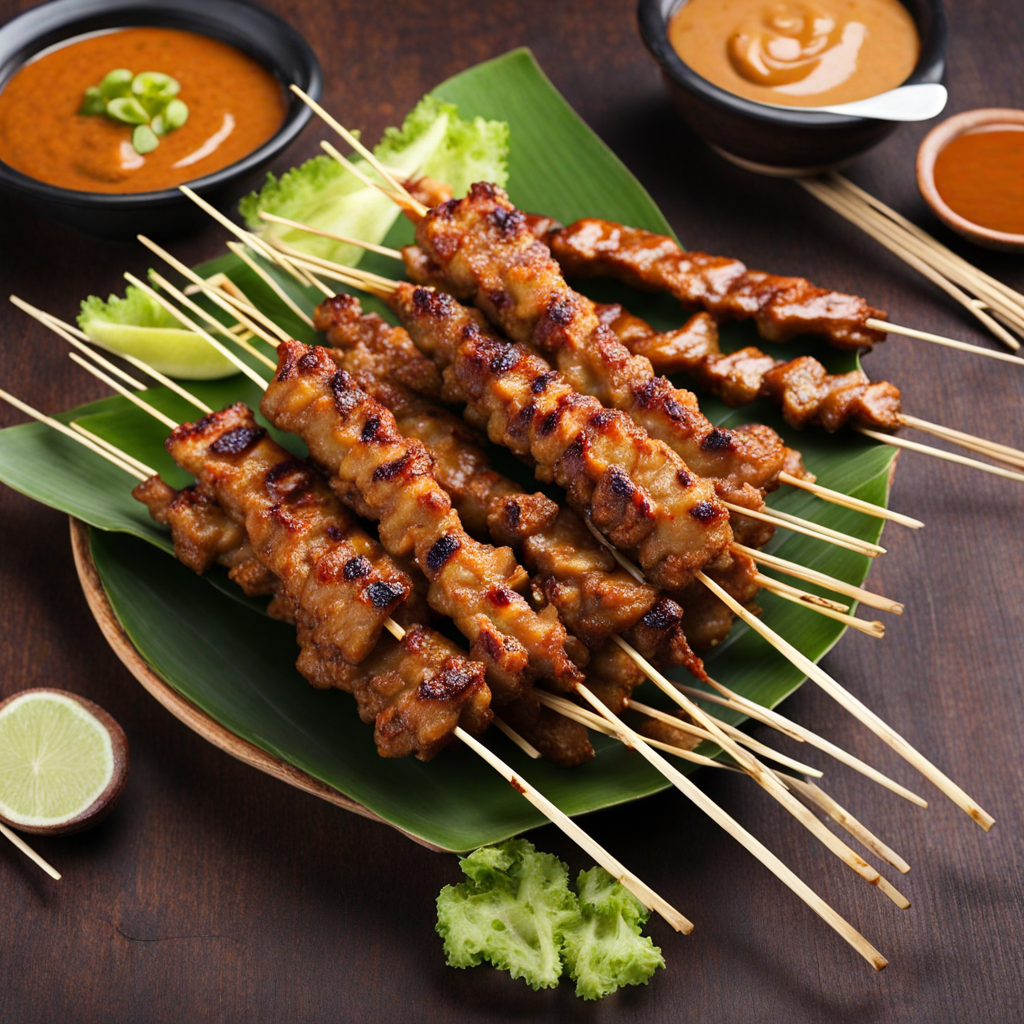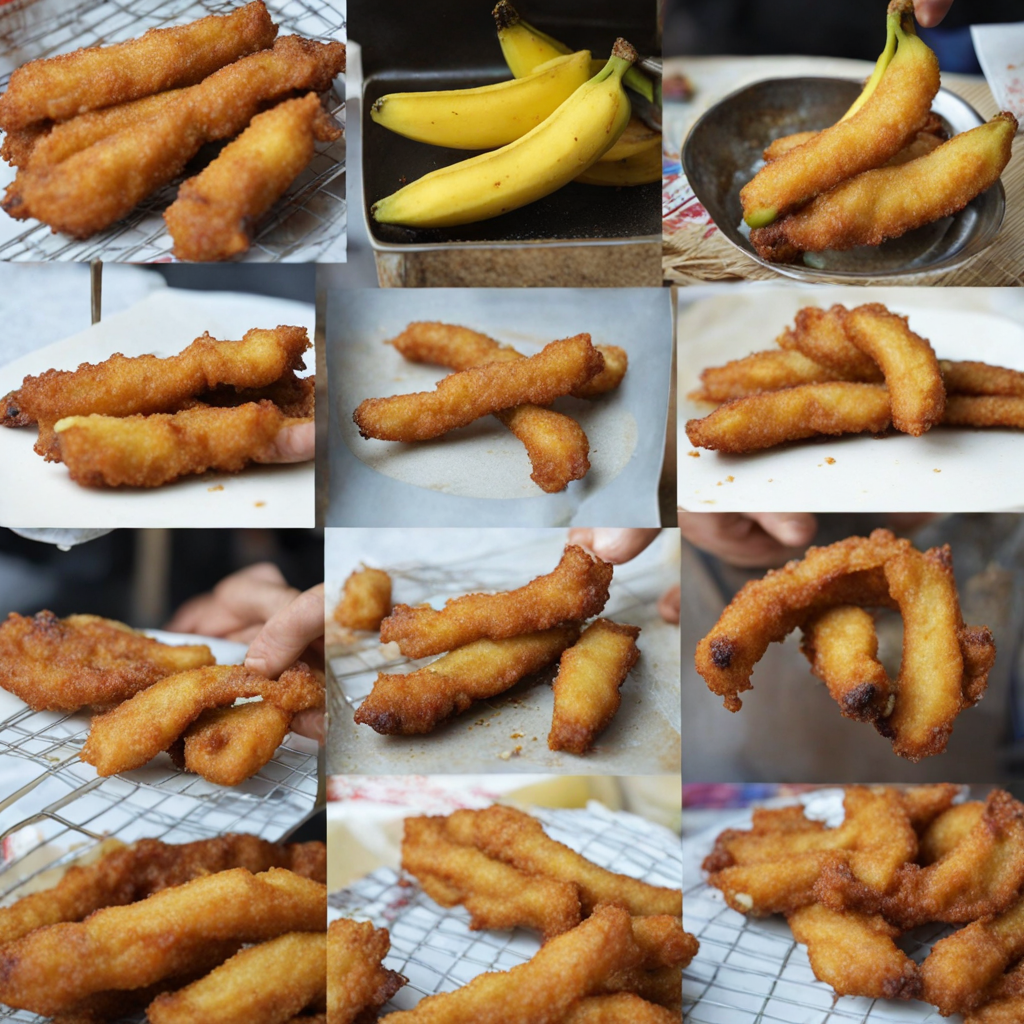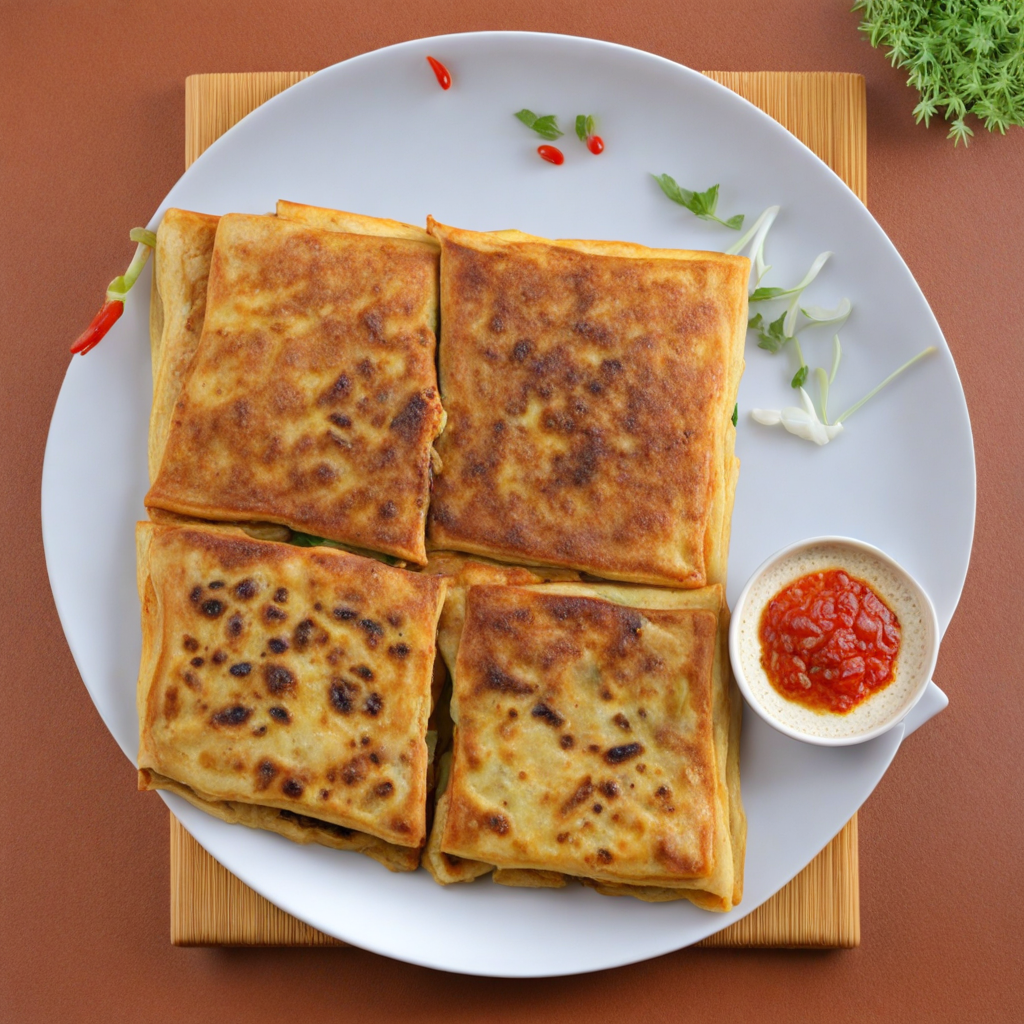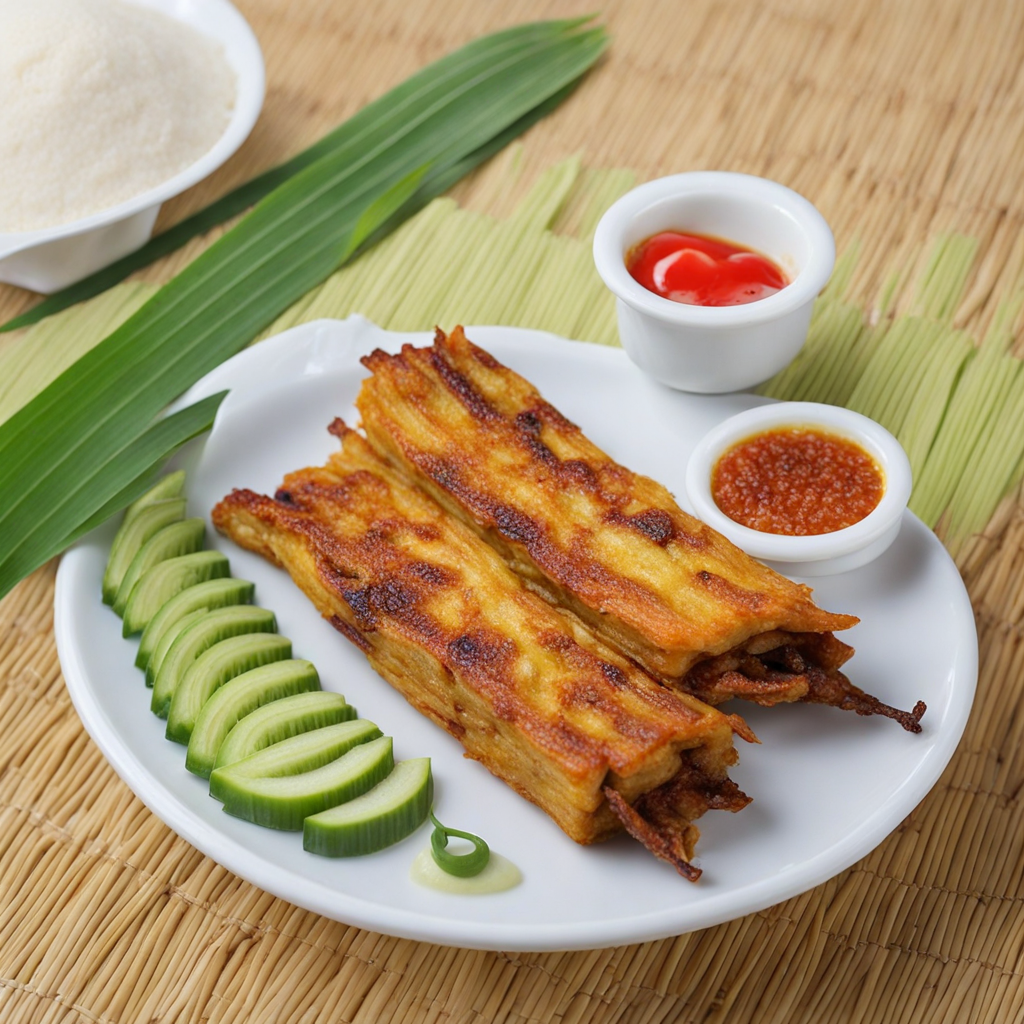Satay
Satay is a beloved Malaysian street food that consists of skewered and grilled meat, typically marinated in a blend of spices that reflects the vibrant flavors of the region. Common meats used include chicken, beef, and lamb, which are cut into bite-sized pieces and threaded onto bamboo skewers. The marinade often includes ingredients such as turmeric, coriander, and cumin, giving the meat a fragrant aroma and a golden hue when grilled. The skewers are cooked over an open flame, which imparts a smoky char that enhances their flavor, creating a tantalizing dish that is both savory and slightly sweet. The dish is typically served with a side of peanut sauce, a rich and creamy concoction that complements the grilled meat perfectly. The peanut sauce is made from ground roasted peanuts blended with coconut milk, sugar, and spices, providing a delightful balance of nuttiness and sweetness. Alongside the satay, you’ll often find a refreshing accompaniment of cucumber slices, onion wedges, and rice cakes, which add a crisp texture and help to cleanse the palate between bites. This combination of flavors and textures makes each bite an exciting culinary experience, inviting you to savor the harmonious blend of spices. Satay is not just a meal; it’s a social experience often enjoyed at gatherings and night markets, where the vibrant atmosphere adds to the enjoyment of the food. The act of sharing skewers among friends and family fosters a sense of community, making it a favorite dish at celebrations and casual get-togethers alike. Whether enjoyed as a snack or as part of a larger meal, satay offers a taste of Malaysia that is both unique and unforgettable, capturing the essence of the country’s rich culinary heritage.
How It Became This Dish
The Story of Satay: A Culinary Journey from Malaysia Satay, a dish that has captured the hearts and palates of food lovers around the world, is more than just skewered meat grilled over an open flame. It is a culinary treasure with deep roots in the rich cultural tapestry of Malaysia and Southeast Asia. This delightful dish not only showcases the region's diverse flavors but also reflects the historical interactions between different cultures. #### Origins of Satay Satay is believed to have originated in the Indonesian archipelago, specifically Java, where it is known as ‘sate.’ The word ‘sate’ is thought to derive from the Arabic word ‘sata,’ which means ‘to slice.’ This connection highlights the influence of Arab traders who brought their culinary traditions to the region. However, as the dish spread through Southeast Asia, it took on various regional characteristics, particularly in Malaysia, where it became an integral part of the local food culture. The earliest mentions of satay date back to the 19th century, where it was primarily found in the streets of Java and later in Malaysia. The dish was made with marinated meat, usually chicken, beef, or lamb, skewered on bamboo sticks, and grilled over charcoal. The marination process typically involved a mix of spices, including turmeric, coriander, and lemongrass, which imparted a unique flavor profile that made it irresistible. #### Cultural Significance Satay holds a special place in Malaysian cuisine, symbolizing the country's rich multicultural heritage. Malaysia is home to a diverse population made up of Malays, Chinese, Indians, and various indigenous groups, each contributing to the culinary landscape. Satay is often associated with celebrations, festivals, and social gatherings, making it a food that brings people together. In Malaysia, satay is commonly served with a peanut sauce, cucumber, onions, and ketupat (rice cakes). The peanut sauce, sweet and slightly spicy, adds a layer of richness to the dish and is a quintessential component that differentiates Malaysian satay from its Indonesian counterpart. The practice of sharing food, especially satay, fosters a sense of community and hospitality, which is deeply ingrained in Malaysian culture. The popularity of satay has led to its inclusion in various local festivities, such as weddings, religious ceremonies, and food fairs. It is often seen as a street food staple, with vendors setting up stalls at night markets and festivals, making it accessible to everyone. The dish is not just food; it is a cultural symbol that reflects the warmth and diversity of Malaysian society. #### Development Over Time As Malaysia evolved through the 20th century, so did satay. The post-colonial era saw an influx of different culinary influences, which contributed to the evolution of satay. The introduction of new spices and cooking techniques allowed for greater experimentation, leading to variations of the traditional dish. In the modern era, satay has transcended its humble street food origins. It has found its place on the menus of high-end restaurants, showcasing the dish's versatility and sophistication. Chefs have begun to experiment with different types of meat, such as venison or seafood, and unique marinades, incorporating global flavors while still respecting the traditional roots of the dish. Moreover, with the rise of global food trends, satay has gained international acclaim. Food enthusiasts around the world have embraced satay, leading to fusion variations that blend different culinary traditions. For example, in Western countries, it has been adapted to include ingredients like teriyaki sauce or served with various dipping sauces beyond the traditional peanut sauce. The growing interest in Malaysian cuisine has also played a significant role in popularizing satay internationally. Malaysian food festivals, cooking classes, and pop-up restaurants have introduced global audiences to the delightful flavors of satay. Additionally, the rise of social media has allowed food lovers to share their experiences, furthering the reach of satay beyond its geographical origins. #### Satay in Contemporary Malaysia Today, satay remains a beloved dish in Malaysia, with numerous variations reflecting the country’s diverse ethnic backgrounds. Each state has its own take on satay, with different marinades and cooking styles that highlight local ingredients. For instance, in Penang, satay is often served with a spicy sambal sauce, while in Kuala Lumpur, vendors may offer a variety of meats, including rabbit and fish, catering to the evolving tastes of consumers. Street food culture continues to thrive in Malaysia, and satay vendors are a staple at night markets, food courts, and festivals. The aroma of grilling skewers combined with the sizzling sound of meat cooking over an open flame draws crowds and creates a lively atmosphere. Family-run businesses often pass down traditional recipes through generations, ensuring that the essence of satay remains intact while adapting to contemporary trends. #### Conclusion Satay is more than just a delicious dish; it embodies the rich history, cultural significance, and culinary evolution of Malaysia. From its origins in the Indonesian archipelago to its status as a beloved street food and fine dining dish, satay has traveled through time and space, adapting and transforming while retaining its core identity. As globalization continues to influence culinary landscapes, satay stands as a testament to the power of food to connect people, celebrate diversity, and create lasting memories. Whether enjoyed at a bustling night market in Kuala Lumpur or a gourmet restaurant in New York, satay remains a symbol of Malaysia’s rich culinary heritage, inviting everyone to savor the flavors of this extraordinary dish. Through each bite, one can taste the history, culture, and passion that make satay an enduring classic in the world of food.
You may like
Discover local flavors from Malaysia


